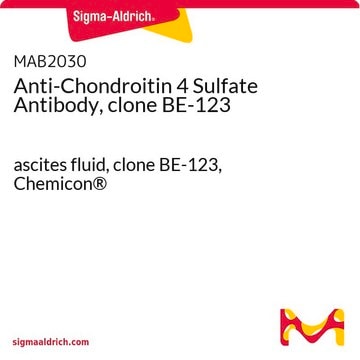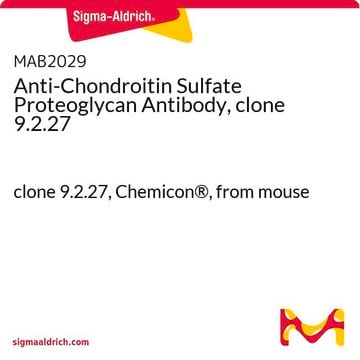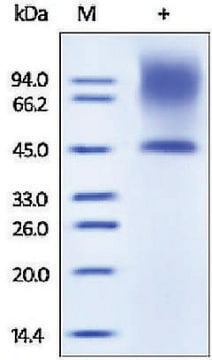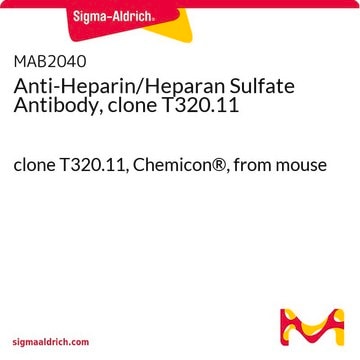SAB4200696
Anti-Chondroitin Sulfate antibody, Mouse monoclonal
clone CS-56, purified from hybridoma cell culture
Sinónimos:
CSPG, chondroitin sulfate proteoglycan
About This Item
Productos recomendados
biological source
mouse
Quality Level
antibody form
purified from hybridoma cell culture
purified immunoglobulin
antibody product type
primary antibodies
clone
CS-56, monoclonal
form
buffered aqueous solution
species reactivity
mouse, chicken, bovine, human
packaging
antibody small pack of 25 μL
concentration
~1 mg/mL
technique(s)
immunofluorescence: 2.5-5 μg/mL using bovine BMGE cells
immunohistochemistry: 2.5-5 μg/mL using heat-retrieved formalin-fixed, paraffin-embedded human colon cancer sections and Biotin/ExtrAvidin ®-Peroxidase staining system.
isotype
IgM
shipped in
dry ice
storage temp.
−20°C
target post-translational modification
unmodified
Gene Information
human ... CSPG4(1464)
General description
Chondroitin sulfate proteoglycan 4 (CSPG4) or nerve/glial antigen 2 (NG2) is encoded by the gene mapped to human chromosome 15q24.2-15q24.3. It is a growth-inhibitory chondroitin sulfate proteoglycan (CSPG) produced after spinal cord injury. It has a single glycosaminoglycan (GAG) chain. The protein belongs to the transmembrane chondroitin sulfate proteoglycans family.
Immunogen
Biochem/physiol Actions
Physical form
Storage and Stability
Other Notes
Legal Information
Disclaimer
¿No encuentra el producto adecuado?
Pruebe nuestro Herramienta de selección de productos.
Storage Class
12 - Non Combustible Liquids
wgk_germany
WGK 1
flash_point_f
Not applicable
flash_point_c
Not applicable
Certificados de análisis (COA)
Busque Certificados de análisis (COA) introduciendo el número de lote del producto. Los números de lote se encuentran en la etiqueta del producto después de las palabras «Lot» o «Batch»
¿Ya tiene este producto?
Encuentre la documentación para los productos que ha comprado recientemente en la Biblioteca de documentos.
Los clientes también vieron
Therapeutic Target in Malignant Cancer
Nuestro equipo de científicos tiene experiencia en todas las áreas de investigación: Ciencias de la vida, Ciencia de los materiales, Síntesis química, Cromatografía, Analítica y muchas otras.
Póngase en contacto con el Servicio técnico














